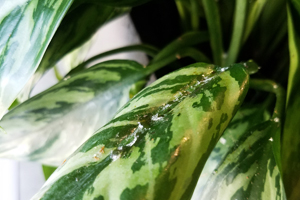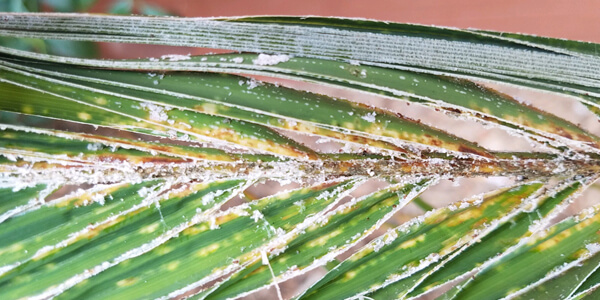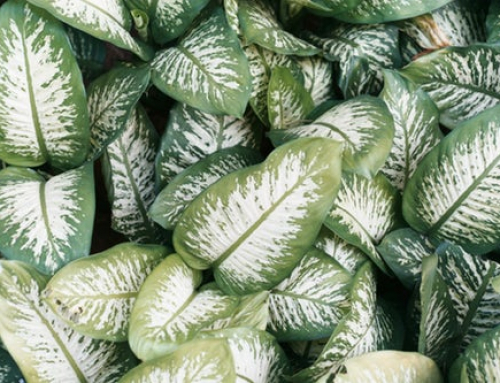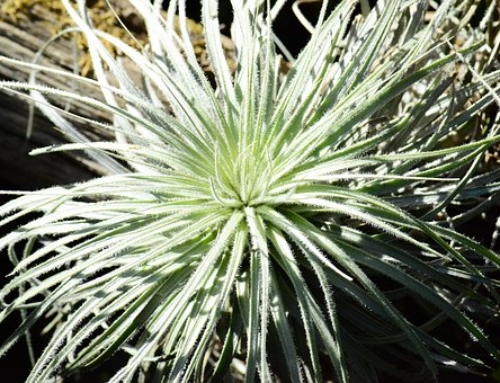
Mealybug are active in the spring
To some Spring means the scent of spring bulbs wafting through the air, to others it means lovely bird songs, but to those of us in horticulture, Spring means it’s insect season. Spring finds us with populations exploding of various insects and mites on our plant friends. As temperatures start to rise and daylight lengths get longer, plants start to grow and so do the insect populations.
Seemingly overnight, spider mite populations show up. Aspidistras are webbed over. Aphids appear on the new growth of Hederas, Scheffleras and Aralias. The floor under the Ficus is suddenly sticky from the scale insects that have taken up residence in the limbs overhead. It’s time to get busy and gain control over these ever increasing populations.
The best plan of attack for controlling insects and mites is to be proactive and find the population before it gains the upper hand. Start today to closely inspect the leaves and branches searching for any signs of a bug outbreak. At this time of year, the pests are near and ready to invade. Some plants are just more susceptible to certain kinds of insects and mites. Brush up your knowledge of which plants are favorites for the different pests and check these plants with each visit. For starters check every Hedera, Schefflera, Aralia, Aspidistra, Dracaena marginata, Codiaeum, and Citrus that you have in each and every account. Add you personal “favorite” plant to this list and go check out these plants. If you need help spotting them these critters there are tools to help your search. Take a magnifying glass with a built in flashlight to illuminate the subject (a cool one available at Radio Shack) or even a clean diaper wipe to swipe across a leaf and see what colors turn up. (If your wipe comes away green your plant’s got mites or thrips.)
Once you spot them or even if you just suspect them, take charge by using several methods of pest control. By blending control methods such as cultural, mechanical, biological and least-toxic chemicals, you are practicing Integrated Pest Management (IPM). The following treatment strategies can help control the populations and keep them below damaging levels.
Cultural Control
The first thing you will want to do is reduce any plant stress by managing the plant’s environment. Such as
- Ask yourself whether this is the best plant variety for this location.
- Check the moisture; make sure that the plant is getting optimum water… not too much or too little.
- Maintain proper pH and fertilizer levels.
- Stabilize temperatures to avoid extreme hot/cold fluctuations.
- Increase the light within the canopy by pruning out dense foliage, moving the plant closer to the window or adding artificial lighting.
Cultural controls don’t eliminate pests that are already established, but they will reduce some of the stresses that weakened the plant in the first place.
Mechanical Control
In addition to improving the plant’s surroundings, tackle the infestation with mechanical controls.
- Use your pruners, scissors or your fingers to snip off and remove the worst of the pests. Remove the densest infestation, throw it into a plastic bag and tie it off. This gets rid of the area on the plant with the highest concentration.
- Pick off insects with alcohol soaked Paws or wipe them off with baby wipes. Squishing aphids and scale with soapy fingers is another quick removal method. You can also gently scrub off scale from bark with soap and water and a scrubby sponge if necessary.
- Clean off honeydew and sooty mold with a commercial leaf cleaner such as Leaftek, Brand X, Jungle Rain or Tropical Mist.
- Isolate infected plants as well as possible.
Biological Control
Many interiorscape companies incorporate biological pest control methods into their treatment strategies. For biologicals to be effective, the pest population must be large enough to support the feeding activity of the “good bugs.” Using biologicals requires education, commitment and the cooperation your client.
Chemical Control
When you turn to chemicals to help control insects and mites, use the least toxic solutions available.
- Establish a regular routine of cleaning and spraying your plants with mild chemicals. Mix a quart of water with one half teaspoon of mild, phosphate-free soap or soap mixed with rubbing alcohol. Castile soap works to control spider mites and thrips. Brand X works well on aphids, scale and mealybug.
- Some of the inorganic and botanical pesticides available to interiorscapers include insecticidal soaps, horticultural oils, pyrethrum, pyrethrum-based pesticides, diatomaceous earth, sticky traps and Neem oil. Be sure and read material safety data sheets and labels thoroughly and use chemicals only as directed.
Don’t Wait Start Now
Inspect all the plants in your care…even those you “know” very well. Bugs are everywhere and they are just waiting for an opportunity to gain a hold on a plant and enjoy the feast of springtime growth.






